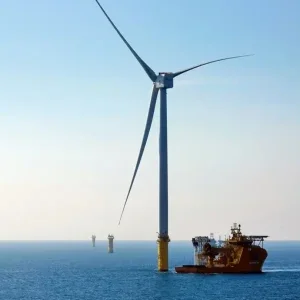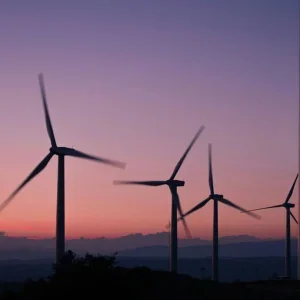Onshore wind may provide the UK’s largest and cheapest source of renewable electricity but with the latest in a series of unfavourable policy changes, the industry is falling victim to the ‘nimbyism’ that has long plagued it. Sarah Williams asks whether a solution could yet be found through greater involvement of communities in the style of countries such as Denmark, speaking to Gemma Grimes of RenewableUK, and Emil Axelsen of the Danish Energy Agency.
Sheep sheltering beneath a turbine in a windswept field has become a new kind of rural idyll for some. Land takes on a dual use, sustainable energy and agriculture co-exist and extra income helps farmers to make ends meets. Currently, 10% of UK farms have installed a wind turbine, and it’s a ‘diversification’ option that the National Farmers’ Union has long been positive about.
Small and medium wind farms, along with larger multiturbine sites, have helped onshore to make up 31% of renewable electricity sources and 5% of the overall electricity supply in the UK. What’s more, onshore is the least expensive low-carbon energy source, is already cheaper than new nuclear, and could be cheaper than new entrant gas by 2020.
Such statistics ought to stand as a positive beacon for the future of onshore across the UK; instead, the industry is reeling from a series of harmful policy changes. Introduced by the new Conservative-majority government in line with a manifesto promise to "halt the spread of onshore wind farms", the measures see subsidy and planning rules taking a blow.
The concern the policy changes primarily seek to address is community opposition – albeit from a vocal minority rather than by the majority of people – which has plagued onshore throughout its growth.
Intended to ensure local people "have the final say on wind farm applications", two new tests for local authority approval in England, introduced in June 2015, make it much harder for planning applications for new sites to succeed.
Meanwhile, the decision to end the eligibility of onshore wind farms throughout the UK for the Renewables Obligation subsidy scheme from April next year, as well as anticipated cuts to the contract for difference (CfD) and feed-in-tariff (FiT) for small-scale turbines, place further financial burden on developers.
Wrecking the route
For Gemma Grimes, director of policy on consents and intelligence at RenewableUK, the changes make it much harder for projects to find a route to market and also impair the speed at which onshore can reach market-comparable affordability.
"We feel that while we are very, very close to cost comparability with new entrant gas, we had hoped for a couple more years to continue to deploy at scale; to continue therefore to bring down costs in order to reach that stage in a smooth and balanced way, while also delivering on renewable energy targets and decarbonisation," she says.
"If we are now forced into a situation where as of now it’s only those projects that are not requiring any financial support to go forward, it does mean that we will see a significant reduction in the capacity of onshore wind, and that ultimately will have an impact on energy costs and on carbon emissions."
Indeed, a recent report by RenewableUK demonstrates that the changes – and the uncertainty that preceded them – have already triggered a downturn. It showed that the number of projects going into the planning system in 2014/15 (until September) was down 64% from the previous year, and developers appear to be focusing on fewer, larger projects where costs can be more quickly recovered.
Any projects that are still viable are likely to be in Scotland, Grimes anticipates. While England has traditionally been a smaller market than Scotland (where 60% of the UK’s operating wind farms are now located), in recent years it had become the secondary market in the UK relative to Wales and Northern Ireland. Today, with the planning changes in place, England has the lowest consent and appeal rate.
It should of course be stated that the issue of community opposition is a genuine one – even though the government’s own opinion polls conducted since 2012 show that two thirds of the public consistently support the development of onshore wind. For a minority though, a range of concerns garner attention, from landscape and visual, to perceived noise levels, impact on animals and driver distraction. However, Grimes highlights that these worries were already taken seriously under the planning legislation previously in existence. She also feels that there is a disconnect between reality and the way wind turbines are represented in the media; noise levels for example.
"The industry has done a lot of research in relation to noise and continues to work very closely with government," she says. "But we feel there is a very big distinction between the perception of how loud things are going to be, based on the things that people read in the media, and the reality.
"A lot of effort has gone in and will continue to go into communicating that. In previous years, we have run a series of onshore wind seminars, where we’ve taken local authority representatives and community groups to visit onshore wind farms and to discuss the range of issues that they perceive with them, but also to get them up close and personal with these projects, so that they are able to see the real impacts first-hand rather than reading or hearing about them somewhere else."
A matter of confidence
While such efforts by industry have attempted to engage communities with onshore wind, the government’s recent decision to sidestep rather than tackle the issue of opposition is problematic, damaging public and investor confidence.
At the same time, the comparable success of onshore wind can be seen in countries such as Denmark and Germany where, above and beyond engaging, actually involving communities is key. This raises the question, has the UK missed an opportunity?
In Denmark, for example, a series of initiatives stemming from its 2008 Promotion of Renewable Energy Act set out to promote the development of wind turbines on land by rewarding local communities. These include compensation for loss of property value, a ‘green scheme to enhance local scenic and recreational values’, a fund to support preliminary investigations into projects and, most importantly, a guaranteed option for local citizens to purchase a stake in turbines.
Emil Axelsen, an adviser for the Centre for Energy Resources at the Danish Energy Agency, explains how the scheme works.
"It’s a requirement that onshore developers offer 20% of the ownership of a particular wind turbine or onshore park so to say, they have to offer at least 20% to local citizens. First you take a radius of 4.5km from the turbine or turbines and you offer it to those who are situated within this area, and then after a certain period you can actually offer it to the whole municipality so that citizens that may not be in the vicinity of the turbines can also be owners.
"Depending on if it’s a municipality that has a good track record, and are good at informing and involving local citizens, you see a higher amount of citizens that want to participate and want to invest in onshore turbines, whereas other municipalities may not have the same interest, so it really depends on what sort of municipality you are dealing with."
Currently in Denmark, wind power covers almost 40% of electricity consumption (Energinet.dk, 2014 figures), and around three quarters of Denmark’s wind capacity comes from onshore wind farms.
Axelsen agrees that the four community schemes have helped to further the progress of onshore wind in Denmark, but also emphasises that Denmark’s political history has played a big role. State determination in the 1970s to create a secure energy supply in the face of oil shortages, and having technology companies on hand to propel progress forward were driving forces for onshore.
Grimes, too, speaks of the historical and political background in highlighting the difference between the two countries when asked whether a Danish-inspired model might yet be possible in the UK. Significantly, she also reveals that this latter subject had been very much under discussion with the previous (coalition) government.
"We spent a long time with the previous government talking about this and trying to perhaps increase the level of similarity between the UK and countries like Denmark when it came to community energy.
"This government however doesn’t seem to have paid much attention to the work that was done under the coalition government, and the work that the industry and community groups tried to do to increase the ability of community groups to develop renewable energy projects, and the extent to which developers, commercial developers and community groups could collaborate."
The UK’s commitment to generating 15% of all UK energy (electricity, fuel for transport and fuel for heating), which translates into 30% of electricity from renewable sources, by 2020 may yet be achievable but it pales in comparison to Denmark’s 50% equivalent. Onshore is a key factor in the latter country being firmly on track to achieving this. However, as Axelsen points out, its continued dominance in Denmark is also under discussion, with politicians increasingly looking to the possibilities of offshore and other energy sources.
A study in wind
One reason is a study launched in 2014 by the Danish Government in partnership with the Danish Cancer Society to investigate the potential health risks of wind energy. The knock-on effect has been that many municipalities have slowed or halted their pursuit of onshore projects. The results of the report, due in 2017, will no doubt influence the future balance of onshore versus offshore.
"It’s a very political subject as to whether the politicians wish to continue with the development, or whether they would rather take a new stance," Axelson says. "Just as in the UK they are talking about reducing subsidies for onshore and offshore, it’s up to the Danish politicians as well to decide would they rather that we mainly have offshore capacity in Denmark, or should we continue with the onshore development? That is a big question of the coming years that will be interesting to follow."
Back in the UK, the political climate seems unforgiving, but at the time of press the outcome of the COP21 UN talks in Paris remains to be seen.
For Grimes, staying upbeat is an occupational requirement. Launched in September, RenewableUK’s ‘People Power’ campaign is encouraging the public to petition their MPs to protect the FiT scheme, and the organisation continues to rally for the benefits of onshore.
"We are optimistic, obviously, because otherwise we wouldn’t be in the business," Grimes says. "But, yes, at the moment it seems that the only part of government that has any kind of authority on these decisions is the Treasury, and of course we feel that that’s only part of the story, and we find that rather concerning. So the jury is out as to whether our efforts will be successful or not.






